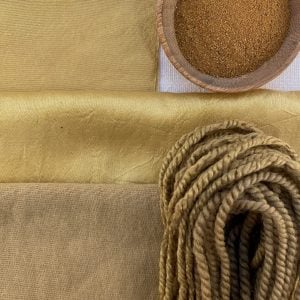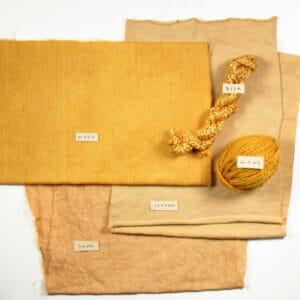We like to use rhubarb root on wool fibers but others have found it to be successful on cotton, linen and hemp as well. Use an alum or symplocos mordant for yellow shades. An iron mordant will create olive greens and an alum mordant with an iron post bath will create deep blackened olive shades.
Fiber Preparation and Mordanting
We offer scouring and mordanting instructions for wool, alpaca, silk (protein), cotton and plant (cellulose) fibers. Your fiber should be scoured and mordanted before dyeing.
Extracting the Dye
This powder has been ground from whole roots and is ready to be simmered in water for 30-60 minutes, then strained to make the dye bath. Use 10% of the weight of fiber (WOF) for a light yellow to 100% WOF for a rich gold.
Adding Fibers to the Pot
Fill the dye pot with water so that the fibers move easily. Add the extracted liquid and stir well. Add the wet, mordanted fibers to the cold dye pot and begin heating the water and bring to about 90 degrees F (33 degrees C), rotating the goods gently. Hold at this warm temperature for 30 minutes, then bring the temperature up gradually to 180 degrees F (80 degrees C), rotating gently. Hold at this temperature for 30-45 minutes, rotating regularly.
Rinsing
Using the same temperature water as your dye bath, rinse the dyed goods once or twice to remove excess dye, then wash gently in a neutral liquid soap. Dry away from direct sunlight.
Reusing Dye Baths and Disposal of Dye
Any exhaust baths with dye color left in them may be used to dye additional materials. I keep extra small skeins of mordanted wool yarn and throw those into the exhaust baths. There will usually be some residual color in the dyebath, even after using the exhaust bath. Dispose of the used dye baths in accordance with your local municipal guidelines. The strained materials from extracting the dye may also be used in eco printing or bundle dyeing.






